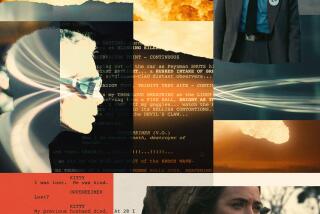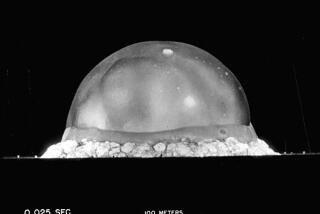Book Review: A history of the upending of physics in “Quantum”
- Share via
Quantum
Einstein, Bohr, and the Great Debate About the Nature of Reality
Manjit Kumar
W.W. Norton, 448 pp.; $27.95
If thinking about the quantum theory doesn’t make you schwindlig (dizzy), then you haven’t understood it, Niels Bohr, its great patriarch, famously (well, famously among physicists) remarked. Quantum mechanics lies at the subatomic base of physical reality — and ruptures any attempts to visualize it. This doesn’t worry many physicists, who use quantum mechanics to correctly calculate the behavior and attributes of the stupefyingly small and choose to disregard its weirdness. It certainly doesn’t worry most nonphysicists; we go about our lives anyway, heedless of the Problem. It worried Albert Einstein profoundly until the day he died. Are you smarter than Einstein?
The British science writer Manjit Kumar has written an intellectual history of the upending, in the 1920s, of classical, Newtonian physics, whose descriptions of an objective, causal reality coincide with our intuition. But quantum theory is counterintuitive. It tells us that a subatomic particle — an electron, say — is in no particular place until it is observed. (Since you cannot see an electron, “observed” here means determining its position experimentally.) It tells us that if you want to know how fast the electron is traveling, then you will have to give up knowing just where it is. It tells us, even, that an electron can be in two places at the same time. The same electron. The various predictions that quantum theory makes have been confirmed in countless experiments.
I recall having all this explained to me in the mid-1960s, over a three-hour lunch in an Italian restaurant in midtown Manhattan, by a frightened science journalist who had just learned that the bit about finding an electron in two places at once had been confirmed by the so-called double-slit experiment. Suffice to say that contemplating this made me and my lunch partner so schwindlig that by the last half-hour neither one of us was sure that the other was actually there. What Bohr might also have said is that once you grasp, however dimly, the implications of quantum theory, your life will never be the same.
This is a very good and thorough history of the quantum revolution, which is not to say that it’s a particularly easy read. Unlike many books about physics for laymen, there are no equations in it — except for a couple of “simple” ones about an inch long describing the uncertainty principle, Werner Heisenberg’s discovery that you cannot simultaneously determine the position and momentum of a subatomic particle. But the ideas are difficult, as you might expect from the book’s subtitle, heralding “the Great Debate About the Nature of Reality.”
The principals in this great debate are Bohr, whose physics institute championed the counterintuitive “Copenhagen interpretation” of quantum physics, and Einstein, who objected to Bohr’s “renunciation of the representation of a reality ... independent of observation.” Einstein believed, to put it simply, that an electron exists — and exists in a particular place — regardless of whether it is being observed. Bohr, and his disciple Heisenberg, believed that “until an observation or measurement is made, a microphysical object like an electron does not exist anywhere,” and that “it was no longer possible to make the separation that existed in classical physics between the observer and the observed.”
Kumar leads the reader as carefully as he can through the thicket of permutations that led to the completion of the theory and its eventual experimental confirmation (although his description of the Einstein-Podolsky-Rosen paradox, a vain attempt to dethrone it, may make you feel as if you’re meeting yourself coming and going). He leavens the mind-bending with sketches of the remarkable human beings involved in this godlike enterprise. Among them: Max Planck, the “reluctant revolutionary” who discovered and named the quantum in 1900, when he was “forced to accept” his own data showing that radiation is emitted and absorbed in packets. The insouciant Heisenberg, young enough to be able to turn his back on classical concepts with no regrets. Erwin Schrödinger, 14 years older, who invented a rival mechanics while vacationing with his mistress in the Alps and refused to accept nature’s fundamental discontinuity — even to the point of collapsing on a visit to the Bohrs after a marathon debate with his host (“Bohr sat on the edge of the bed and continued the argument” ). And the acerbic Wolfgang Pauli, nicknamed “The Wrath of God,” whose intelligence scared people and who read Einstein’s papers on general relativity under his desk in high school “when bored by a particularly tedious lesson.”
Pauli is said to have rocked back and forth while he was thinking hard. You might try this on your way through Kumar’s book. It’s a wonderful trip and one you should embark on if you’re interested in just what exactly is at the bottom of the garden.
Lippincott is a free-lance editor specializing in science.
More to Read
The biggest entertainment stories
Get our big stories about Hollywood, film, television, music, arts, culture and more right in your inbox as soon as they publish.
You may occasionally receive promotional content from the Los Angeles Times.










